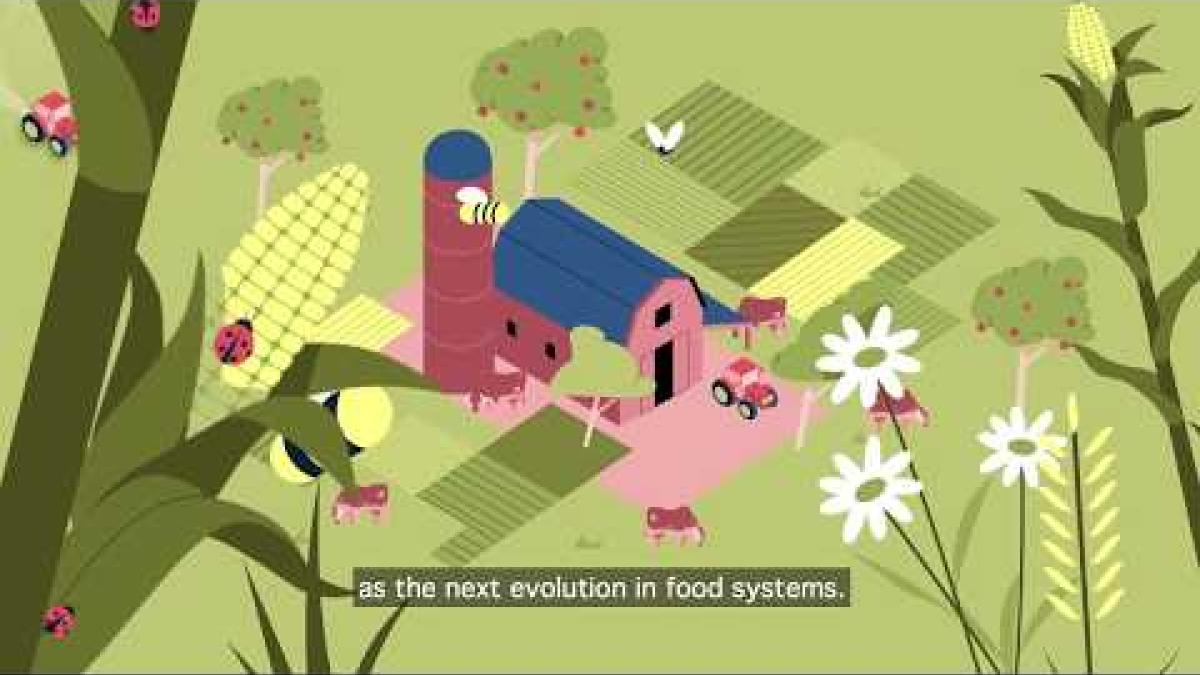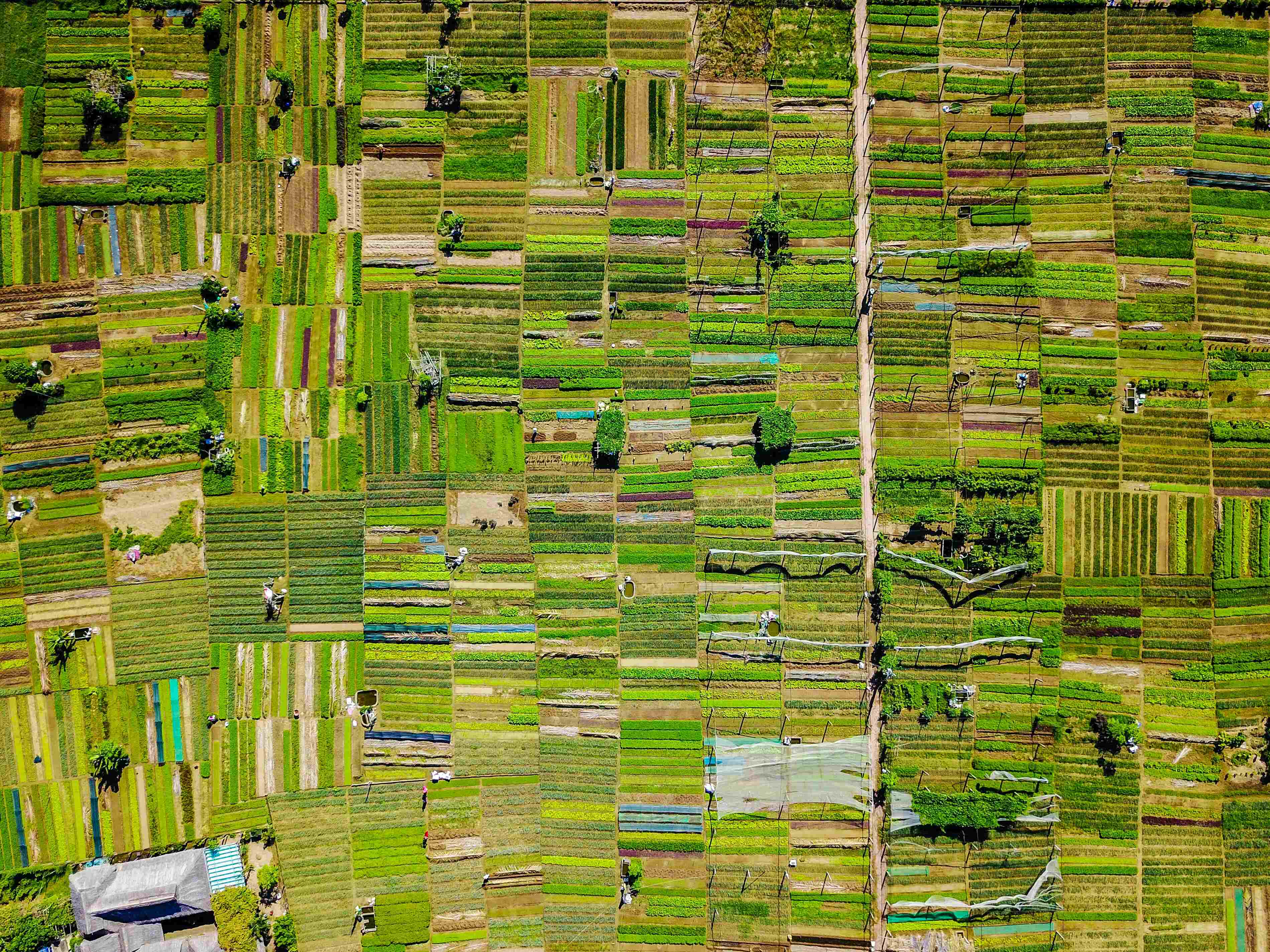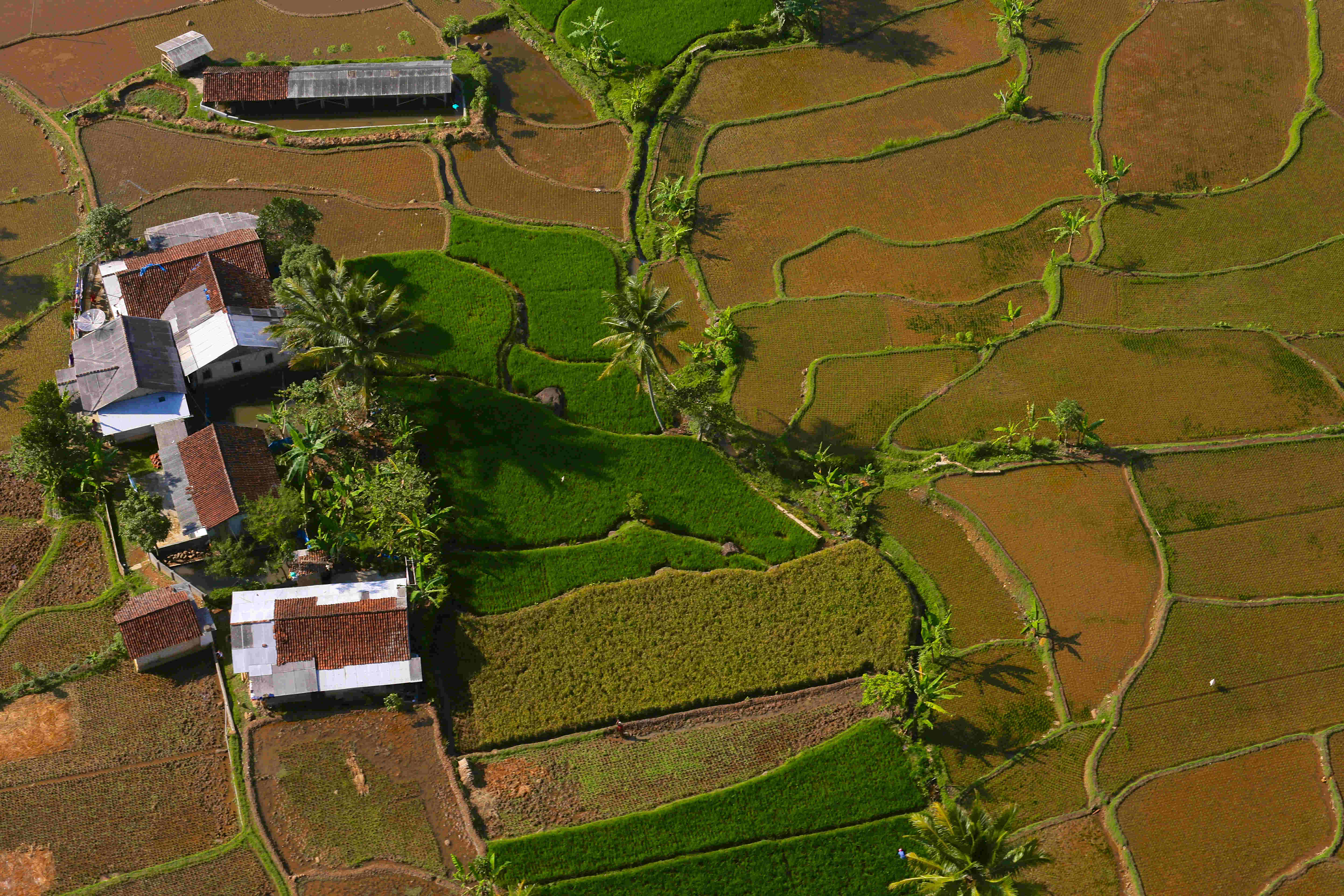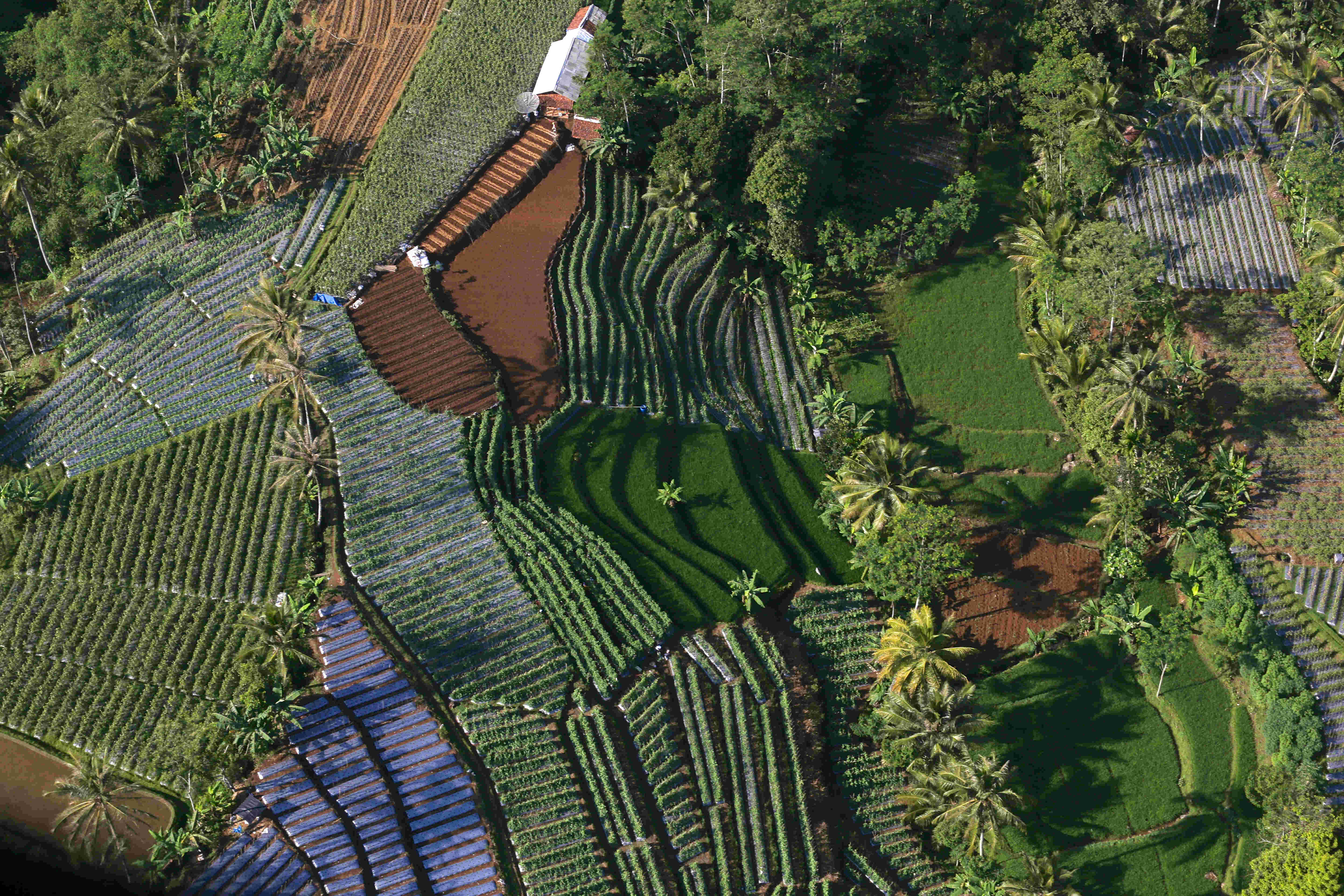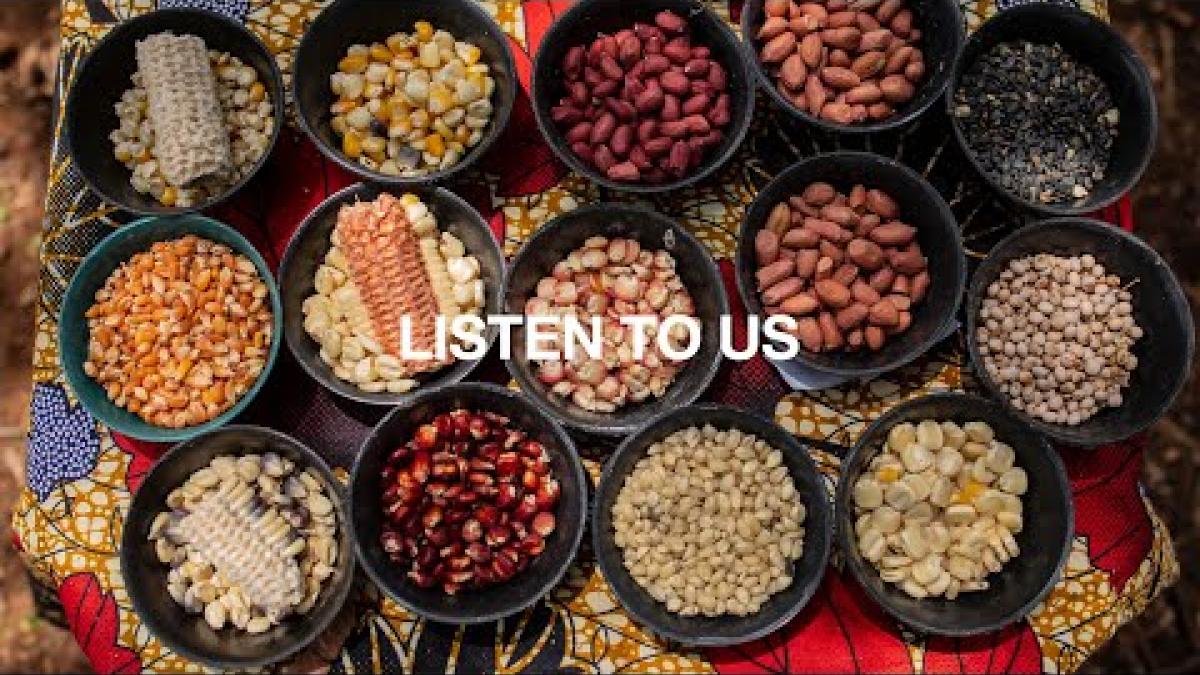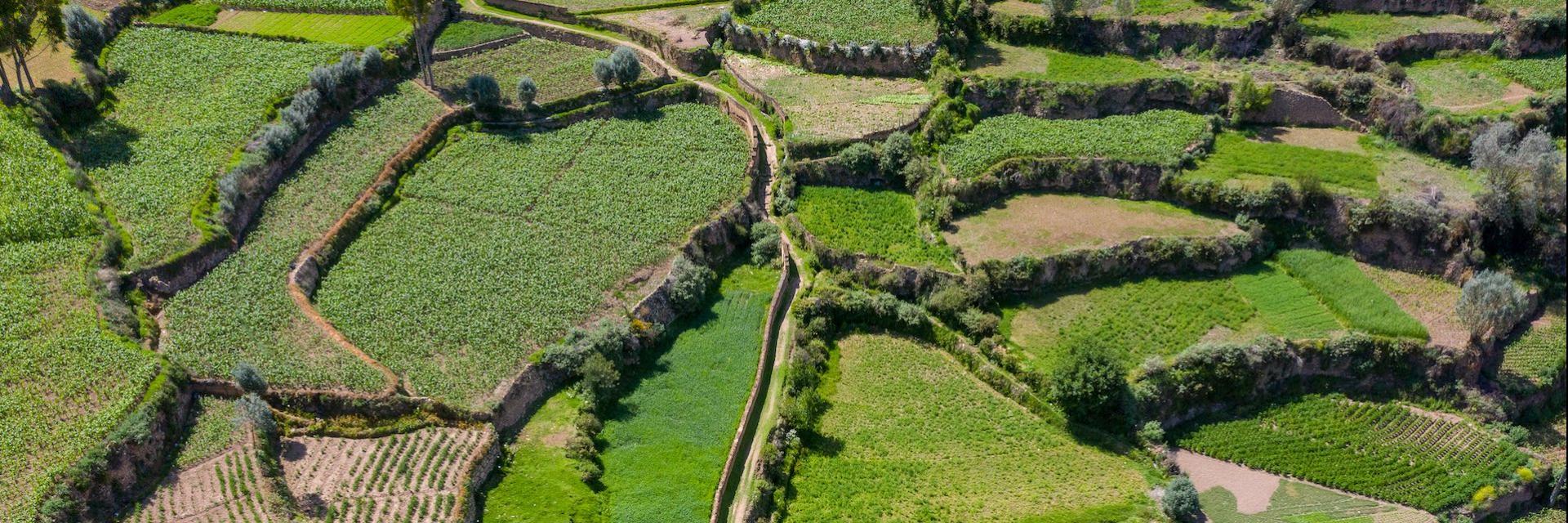
Andenes or platforms for agriculture in Peru.
Credit: Christian Vinces / Adobe StockAgroecology
Restore and employ food systems based on agroecology to reduce poverty, end hunger, heal damaged land, sequester carbon, and improve health.
Agroecology is a nature-based food production system integrating biology, ecology, sociology, economics, and activism. Utilized around the world, it is simultaneously a scientific discipline, a suite of time-tested regenerative farming practices, and a social movement. Agroecology views agricultural areas, whether small or large, as ecosystems. It combines Indigenous and traditional agriculture with multidisciplinary scientific research and new technology, with the goal of increasing food production, improving livelihoods for farmers, strengthening food security and nutrition, reducing pesticides, replenishing soil health, supporting wildlife, and building resilience to climate change. It can end hunger. It creates equitable food systems. It values diversity, localized solutions, and interdependence. It has a role in urban environments as well.
Action Items
Individuals
Learn why the social and environmental benefits of agroecology make it a “must do” alternative to industrial agriculture. Agroecology is widely practiced around the world, particularly among Indigenous, traditional, and smallholder farm communities, where it has produced food regeneratively for centuries. In many nations, however, it has been replaced by an industrial food system that treats agricultural crops as a commodity, employing a lengthy list of destructive practices, including growing crops with chemicals that kill biology in the soil. Repeated plowing causes soil erosion, resulting in a loss of stored carbon. In contrast, agroecology provides healthy food and heals the land. It is the foundation for regenerative solutions: see Plant Diversity Nexus, Regenerative Agriculture Nexus, Agroforestry Nexus, and Degraded Land Restoration Nexus. The term agroecology was coined in 1928. Although precise definitions vary, agroecologists share core practices (see Farmers and Ranchers below).
- As a science, agroecology emerged in the 1960s with a focus on the biological interactions between soils and plants. It expanded to include social sciences and the study of entire food systems. Recent research is tackling justice, equity, food insecurity, and adaptation to climate change. It is exploring Indigenous knowledge and practices. Here is a sample of research articles.
- Agroecology has emerged as a strategy to oppose industrial agriculture and demand the implementation of food systems that respect the environmental limits of our planet. La Via Campesina is a global organization using agroecological practices and principles to fight for peasants’ rights, seed security, and food sovereignty. In Canada, the National Farmers Union promotes agroecology via education and advocacy.
- The People’s Agroecology Process is an organizing campaign in the Americas. They have published a guide to their work and history.
- “Who Will Feed Us” is a report from the ETC Group on an agroecological alternative to the industrial food system.
- Activist Vandana Shiva explains why agroecology is a necessary solution for climate change.
- Agroecology boosts the livelihoods of family farmers by reducing their dependence on external agricultural inputs. It proves multiple ecosystem services, which are the essential services that nature provides, such as nutritious food, clean water, pollination of crops, pollution removal, carbon sequestration, and recreational, cultural, and spiritual benefits. It provides opportunities for youth and women to become their own agents of change.
- Agroecological food systems that provide food security and nutrition are the subject of a report from the World Committee on Food Security.
- Digitization and other technological innovations are helping to integrate agroecological practices with diverse farming communities.
- Agroecology can be implemented in cities. In Spain, a National Network of Cities for Agroecology supports the development of sustainable food policies (see Urban Farming Nexus and Nature of Cities Nexus).
- Eleven Frequently Asked Questions about agroecology are answered by Biovision, a nonprofit organization.
Learn about the diversity of agroecological systems around the world. Marginalized for decades, many Indigenous peoples, traditional cultures, and smallholder farms are now leading an agroecology revolution as the benefits of their regenerative systems become clear. FoodTank has a list of eighteen organizations that are building stronger food systems through agroecology. Other examples include:
- Farmer-managed Natural Regeneration is a practice that nurtures trees to grow from former stumps, resulting in hundreds of thousands of acres being reforested in Africa’s Sahel region.
- Agroecology has improved women’s lives in Togo.
- In Colombia, the Indigenous Zenu have turned to agroecological methods and seed saving to adapt to drought and other effects of climate change.
- The MagosVölgy Ecological Farm in Hungary puts agroecology into practice using local resources. It is part of a wider trend in Hungary.
- Ten case studies of smallholder farms practicing regenerative agriculture and agroecology demonstrate their value in alleviating hunger and poverty.
- In Chile, agroecology helps beekeepers and farmers thrive.
- In Zimbabwe, agroecological research is helping communities intensify food production to adapt to changing conditions.
- Pastoralism is a type of agroecology that involves livestock. Ten case studies from Africa explain its potential (see Pastoralism Nexus).
- The University of Vermont is launching an Institute for Agroecology.
- The Alliance for Food Sovereignty in Africa’s collection of case studies shows how agroecology benefits poverty reduction, climate change adaptation, and wildlife conservation. Here is a story about farmers in Zimbabwe.
- In Guatemala, agroecology schools are helping communities restore degraded land.
- This report explains how agroecological practices can help communities adapt to climate change. Examples of successful approaches to adaptation can be found here.
- The Agroecology Research Group at the University of California, Berkeley, has conducted work on vineyard agroecology.
- Using agroecology, Vietnam is positioning itself as a food innovation hub for Asia.
- In pre-colonial Mexico, inhabitants of the Valley of Mexico built floating gardens called chinampas. They are viewed today as a highly productive form of agroecology.
Support agroecology by buying directly from farmers and ranchers who practice regenerative agriculture or from retailers who support them. Purchasing products from agroecological farms and ranches encourages other farmers and ranchers to adopt similar practices and goals. See Regenerative Agriculture Nexus, Perennial Crops Nexus, and Plant Diversity Nexus for more suggestions.
- Eat at a restaurant that supports agroecological and regenerative agriculture. Here is a list of restaurants from Zero Foodprint.
- A sample of companies that support regenerative agriculture include Alter Eco Foods, Maple Hill Dairy, Dr. Bronner’s, Annie’s, Lundberg Family Farms, and Nature’s Path.
- The Savory Institute has a certification program called Land to Market that measures verifiable ecological outcomes. Partners include Epic Provisions, Applegate Foods, Ugg, Timberland, and Kering.
- Patagonia Provisions sells food and other products that are certified regenerative organic from participating farms and ranches.
- Grass-fed meat and dairy are often produced by regenerative agriculture. A good example is Cream Co. Meats. Eat Wild has a directory of other farms and ranches in the U.S. and Canada.
- Wildlife and bird-friendly beef, such as Audubon’s Conservation Ranching Program and Blue Nest Beef, are often produced by regenerative ranchers. Here is a buying guide from the Audubon Society.
Beware “junk agroecology.” Agribusinesses have begun to co-opt the term agroecology for their own purposes. These corporations tend to showcase small advances in single practices, such as improving soil health, that allow them to appear sustainable while falling short of more holistic solutions.
- “Junk Agroecology” is a report from Friends of the Earth International that details how the purveyors of junk agroecology want to perpetuate the ills of the industrial food system under the guise of “sustainable agriculture.”
- Many groups representing Indigenous and agroecological food systems felt they were marginalized in favor of corporate agribusinesses at the United Nations’ World Food Summit in 2021.
Get trained and/or earn an education certificate in agroecology. There are many opportunities to deepen your knowledge. Programs include:
- An Agroecology M.S. offered by the University of Wisconsin–Madison, including a research track and a public participation track.
- The University of Vermont has an undergraduate program called Agroecology in Action.
- The University of California, Santa Cruz, offers multiple programs at its Center for Agroecology.
- Programs of study in agroecology in the United States can be found at Universities.com and Stateuniversity.com.
- The International People’s Agroecology Multiversity has a network of field learning sites in South Asia that provides training in agroecology.
- The Ecological Society of America provides educational resources on agroecology.
- The European Association for Agroecology provides an online game called Segae in which a player pilots a virtual farm and implements agroecological practices to increase its sustainability.
Donate, join, or follow organizations that support agroecology. There are many choices, including volunteer projects and other community-based initiatives that preserve biodiversity (see Key Players below).
- The Agroecology Coalition has online news and publishes a quarterly newsletter.
- The Mongabay news service publishes regularly on agroecology.
Groups
Farmers and Ranchers
Adopt agroecological practices. Expand the scale of your agroecological enterprises as much as possible. Participate in research. Join efforts that change policies and economic conditions to support agroecology. For more information, see Regenerative Agriculture Nexus, Agroforestry Nexus, Animal Integration Nexus, and Plant Diversity Nexus. Practices include:
- Organic no-till is a combination of chemical-free and no-tillage agriculture, often achieved with the use of cover crops.
- Conservation tillage falls between no-till and full-till and usually involves cover crops.
- Cover crops keep the ground covered using a wide variety of plants in order to protect the soil and build organic matter.
- Polycultures and food forests traditionally employ two or more food types grown together, often utilizing trees in a multistory system.
- Agroforestry is the integration of trees and shrubs into crop and animal farming systems. It has been practiced around the world for centuries.
- Composting is the aerobic decomposition of carbon-rich material, such as wood, manure, and food waste, into a soil-enriching amendment (see Compost Nexus).
- Silvopasture is the integration of trees and grazing livestock on the same land, managed intensively for both forest products and forage (see Silvopasture Nexus).
- Perennial crops are trees and vegetables that grow every year without seeding, including olives, asparagus, rhubarb, and globe artichokes (see Perennial Crops Nexus).
Adopt new technology and new training. New agricultural technology and training programs have the potential to boost agroecological yields and make farming more efficient and profitable.
- AgroEcoTech is a report from the Soil Association (UK) on how farmers can accelerate the transition to agroecology.
- A digital decision-making tool is available from the nonprofit Biovision that enables farmers to assess their operations to make them more resilient, equitable, and agroecological.
- Refresh: Food + Tech is a report from the Refresh Working Group on how digital devices, artificial intelligence, and smart software can accelerate the creation of more sustainable, scalable, and equitable food systems.
- The Agroecology & Technology Fieldlab at Wageningen University in the Netherlands is integrating smart technology with regenerative agriculture.
- The Regenerative Organic Alliance has a certification program for farmers and ranchers.
- The Rodale Institute has a training program in regenerative organic practices for aspiring farmers.
- The Soil Health Academy has a Regenerative Agriculture 101 online program designed for farmers and ranchers.
- California State University, Chico’s Center for Regenerative Agriculture and Resilient Systems has a mentoring program for ranchers, as well as numerous educational materials.
Restaurants and Retailers
Offer agroecological products to customers. Identifying food in meals and for sale on store shelves as agroecological will help customers understand the value of the regenerative agricultural practices and principles that produced the food.
- Zero Foodprint, a nonprofit organization that certifies restaurants and food businesses for their use of climate-friendly products, is a role model for agroecology.
- El Fogon Verde is a restaurant in Madrid that uses ingredients from agroecological farms exclusively.
- Food retailers and their environmental policies can drive agroecology practices on the farm.
Scientists
Expand research into agroecological practices and customs, especially its potential to build resilient and equitable food systems. Agroecology is underserved by the research community, particularly the interconnections among sustainable farming practices, social sciences, and cultural heritage and their potential for ending the climate crisis. Researchers need to be inclusive, inviting Indigenous and marginalized voices into their projects and scientific communities. Potential research areas include:
- Exploring links between crops grown by Indigenous, traditional, and smallholder farms and the specific agroecological niches where these crops are raised, including the role they can play in restoring degraded land (see Plant Diversity Nexus and Restoring Degraded Land Nexus)
- Analyzing how agroecology can increase productivity (yield) and farm profitability. Here is an example of the type of research needed.
- Analyze how agroecological practices might scale up and be implemented on bigger farms.
- Analyzing why agroecology isn’t being adopted more widely by farmers beyond those who are currently using it. What are the barriers to the adoption of agroecological principles and practices? What are the social and policy needs for expanding agroecology? What arguments are the most effective?
- Engage citizen scientists in agroecological research.
- Explore links between agroecology and healthy diets.
- Research is needed in balancing the need for new technology with its impacts on traditional lifestyles and biodiversity. Interdisciplinary approaches are needed to build research agendas for the agroecology-based digitalization of farming systems.
- Joining fellow scientists in calling for increased public investment in agroecological research.
Philanthropy
Support agroecological research, implementation, and activism. Many agroecology projects are underfunded and have a difficult time attracting the attention of major foundations.
- In 2023, twenty-five philanthropic organizations issued a joint call for a tenfold increase in funding for regenerative and agroecological projects around the world.
- The Alliance for Philanthropy and Social Investment Worldwide has issued a strategy for funding agroecological movements.
- One Earth supports transitions to regenerative agriculture and agroecological food systems. Here is a list of their projects.
- The Agroecology Fund supports projects around the world that advance agroecology.
- A funders toolkit on climate, health, and equity can help connect funders with other sources of climate-focused philanthropy and provides strategy advice.
- In an open letter, two hundred organizations called on foundations to stop supporting the spread of industrial agriculture in Africa and support agroecology projects instead.
- A network of European foundations is supporting sustainable agriculture and UN Sustainable Development Goals.
Companies
Support agroecology as an economically viable, profitable, and resilient alternative to conventional farming. Agroecology can strengthen businesses, fostering long-term profitability. Challenges and opportunities:
- Help shorten supply chains from the farmer to the customer. Fewer steps can help local producers enjoy higher profit margins. Eosta is a company that distributes fresh and fair organic fruit and vegetables, tracing all products carefully along its supply chain.
- Help develop markets for products. Agroecological businesses often lack access to markets, especially in low-income countries. Here is a story about a partnership between Practical Action and IKEA to help smallholder farmers in Kenya.
- Help build awareness of the benefits of agroecology for customers. Although there is no certification process, companies can promote agroecological products as part of marketing campaigns. Biofit is a Kenyan company that produces animal feed from water hyacinths.
- Help bring digital technology to the distribution and marketing of agroecological products. Here is a story about how digital tools can help African agri-food systems. Here is a research article about how digital technology can facilitate transitions to agroecology.
- Business Fights Poverty is a collaboration of business experts and researchers fostering successful partnerships between companies and farmers.
Governance
Enact laws, policies, regulations, and public research projects that support agroecology and related customs and practices. Agroecology can provide an overarching guide to policies and economic incentives that support regenerative agriculture and sustainable food systems. Its integration of scientific research, practical implementation, and social awareness can help bring together policy sectors and diverse stakeholders that are often disconnected from one another. Consequently, multiple good governance goals can be achieved at a variety of scales and levels. Actions include:
- Remove barriers to farmers and others seeking to transition to an agroecological system, including obstacles to obtaining access to land, water, and crop seed.
- Encourage the development of alternative markets for agroecological products and encourage new producers to enter production. Here is a story about the Peruvian government establishing a portion of the Andes Mountains as an agroecological area for ancient crops.
- Support on-farm innovation for agroecology, including incentive programs, farmer-to-farmer training, public funding for farmer-centered collaborative research, and improved extension capacity to support farmers transitioning to agroecological production.
- Support and incentivize the adoption of practices that build healthy soils and diversified cropping systems. Healthy soils can increase the resilience of agriculture and food systems to climate change.
- Enact policies and programs to support the next generation of farmers, ranchers, and workers while breaking down barriers to entry, especially for people of color and Indigenous people.
- Increase funding for research, extension, and education programs.
- The Agroecology Knowledge Hub of the UN’s Food and Agriculture Organization has policy recommendations for agroecology. Here is a report on the FAO’s work on agroecology worldwide.
- This working paper reviews recent advances in agroecological policies. This report from the Agroecology Policy Research Initiative in Canada identifies levers of change that will advance policies and address challenges, and a related study indicated that politics is the major hurdle and pointed out that agroecology must address historical and ongoing injustices facing Indigenous people.
Key Players
Organizations
Agroecology in Action focuses on putting agroecological knowledge and technologies into practice.
The International Panel of Experts on Sustainable Food Systems (iPES FOOD) is a global think tank and expert group that guides action on sustainable food systems, including agroecology, around the world.
Biovision is committed to climate-friendly agriculture that promotes human health, soil fertility, animal welfare and biodiversity, including agroecological solutions to alleviate poverty in Africa.
Ecoagricultural Partners (Washington, D.C., U.S.) focuses on landscape research, policy advocacy, network building, and regenerative agroecological food systems, training leaders in over 50 landscapes in 20 countries.
Navdanya International (India) has a mission to protect nature, biodiversity, seed sovereignty for people and farmers, regenerative agroecology, and the protection of indigenous knowledge and culture.
Traditional Native American Farmers Association (U.S.) has a mission to revitalize traditional agriculture for spiritual and human needs by creating awareness and support for Native environmental issues.
The Soil Association (UK) is a charity working to transform the way we eat, farm, and care for our natural world, offering a number of certification programs and food campaigns, including agroecology.
Agroecology Commons (U.S.) cultivates knowledge sharing, community action, and global solidarity for decolonized land stewardship, collective healing, and justice within the food movement.
Alliance for Food Sovereignty in Africa (Uganda) is a broad alliance of different civil society actors that are part of the struggle for food sovereignty and agroecology in Africa. They have a sizable list of agroecological case studies.
Australian Food Sovereignty Alliance (AU) is a farmer-led civil society organization working towards just and ecologically sound food and agriculture systems, including agroecology.
Pesticide Action Network International is a network of over 600 participating nongovernmental organizations, institutions, and individuals in over 90 countries working to replace hazardous pesticides with ecologically sound alternatives.
Sustainable Agriculture Tanzania works to implement agroecology among farmers and pastoralists in Tanzania to improve productivity and livelihoods while protecting the environment.
Sociedad Cientifica Latinoamericana de Agroecologia (SOLCA) (South America) promotes discussion and scientific exchange of informationon agroecology among researchers and teachers.
Instituto Agroecologico Latinamericano (IALA) (South America) trains and educates campesinos (country folk) and small-scale farmers in agroecology.
The Berkeley Food Institute (University of California, Berkeley, U.S.) works to create systemic change in food systems, including agroecology, by creating connections between the scholarly community, farmers and other producers, non-governmental organizations, governments, and civil society.
Center for Agroecology (University of California, Santa Cruz, U.S.) is an organization of staff, faculty, and students who advance agroecology and equitable food systems through experiential education, participatory research, agricultural extension, and public service.
One Earth (U.S.) works to accelerate collective action to limit global warming through a transition to regenerative agriculture and agroecology.
Groundswell International (Washington, D.C., U.S.) is a global network of local NGOs working together to transform farming and food systems with regenerative and agroecological practices across West Africa, the Americas, and South Asia.
Soils, Food, and Healthy Communities (Malawi) is a project in which farmers collaborate and exchange knowledge to improve soil fertility, food security, and nutrition using agroecological practices.
The Timbuktu Collective (India) works with marginalized rural people, laborers, women, and youth to improve their lives through agriculture while reclaiming their cultural and ecological heritage.
Premium Hortus is an African tech company that specializes in e-commerce for agroecological products.
Practical Action (UK) is an international development organization that puts business ideas to work to solve rural poverty, including agroecological farming systems.
Agroecology Now! focuses on understanding and supporting the societal transformations necessary to enable agroecology as a model for sustainable and just food systems.
Asian Farmers’ Association for Sustainable Rural Development (Philippines) is an alliance of national farmers' organizations advancing sustainable, resilient, and organic agroecological family farming systems.
A Growing Culture promotes agroecological innovation and food sovereignty for everyone, everywhere.
European Association for Agroecology (Europe) fosters interaction and knowledge sharing to create an inclusive European community of professionals, practitioners, and societal stakeholders in agroecology.
Landworkers Alliance (UK) works for a food and land-use system that regenerates natural resources and cools our planet, with agroecology as a basis for food production.
The Center for International Forestry Research and World Agroforestry (CIFOR-ICRAF) (Worldwide) harnesses the power of trees, forests, and agroforestry landscapes to address the most pressing global challenges of our time.
The Mountain Institute (Lima, Peru) helps communities in the Nor Yauyos-Cochas Landscape Reserve above Lima, Peru adapt to anticipated climate change impacts such as water scarcity.
Civil Society and Indigenous Peoples’ Mechanism (Rome, Italy) is the largest international space of civil society organisations (CSOs) working to eradicate food insecurity and malnutrition.
Crop Trust (Germany) is dedicated to conserving and making crop diversity available for use globally for the benefit of everyone.
Food Tank is a global community that inspires, motivates, and activates positive transformation in how we produce and consume food.
World Future Council identifies solutions, polices, and practices that promote agroecology, food security, and biodiversity.
Food and Agriculture Organization of the United Nations (FAO), leads the UN’s effort to defeat hunger and achieve food security.
International Union for the Conservation of Nature (Switzerland) is the world’s largest and most diverse environmental network.
CGIAR (France) delivers critical science and innovation to transform the world’s food, land, and water systems in a climate crisis.
Individuals
Gary Nabhan is an ethnobotanist, author, and activist for native foods and wild plants in the Sonoran Desert.
Jyoti Fernandes is a farmer and organizer in the UK who works in support of agroecology, food sovereignty, and localized food systems.
Mariama Sonko is an activist for agroecology and food sovereignty in West Africa.
Frances Moore Lappe and Anna Lappe are activists and authors focused on democratic food, climate change, and nature-based farming.
Elizabeth Mpofu is agroecology activist in Zimbabwe and general coordinator for La Via Campesina.
Steve Gliessman is a scientist and professor of agroecology at University of California, Santa Cruz and a leader in agroecology research.
Miguel Altieri is a professor at University of California, Berkeley and a pioneer in agroecology research.
Michael Fakhri is the UN Special Rapporteur on the Right to Food.
Victor Toledo is a Mexican biologist and expert in ethnoecology.
Learn
Watch
Agroecology for Sustainable Food Systems by FAO (4 mins.)
Agroecology: Various Approaches in Europe Euro-EducATES France (39 mins.)
Agroecology: A Farmer’s Perspective by FAO (15 mins.)
Agroecology: Voices from Social Movements by CAWR Coventry University (22 mins.)
Agroecology: Grassroots Solutions to Global Crises by Agroecology Fund (8 mins.)
Earth Talk: Agroecology: Who will feed us in a planet in crisis with Miguel A. Altieri by Dartington Trust (47 mins.)
"Sustainable Farming through Agroecology" by Stephen Gliessman with Mark Bittman by The Edible Schoolyard Project (96 mins.)
A Collection of Short Videos on Agroecology by the Soil Association (2-5 mins. each)
A Collection of Videos on Agroecology with, by, or through Agroecology Now! (3-41 mins. each)
The Soil Story narrated by Larry Kopaid by Kiss The Ground (4 mins.)
Soil Carbon Cowboys by Roots So Deep (12 mins.)
Carbon Cowboys Films Playlist (9-24 mins. each)
How to Start a Regenerative Farm from Scratch by Heifer USA (21 mins.)
Healing the Earth with Regenerative Farming | Gabe Brown by Sustainability Champions (56 mins.)
Civil Eats TV: Regenerative Ranching in a Pandemic by Civil Eats TV (5 mins.)
Meet Your Farmer: Regenerative Renegades by Natural Grocers (23 mins.)
Regenerative Agriculture: Nourishing the Soil, Healing the Planet by Bioneers (10 mins.)
Read
Agroecology and Sustainable Food Systems, a research journal by Taylor & Francis
Agroecology is central to the United Nation’s 2030 Agenda for Sustainable Development, which aims to end poverty and achieve zero hunger while sustainably managing the planet’s natural resources.
The UN’s Food and Agriculture organization (FAO) identified ten common elements to agroecology worldwide: food and plant diversity; cocreation and sharing of knowledge; synergies across food systems; efficiency; recycling; building resilience in communities and ecosystems; equity and social well-being; maintaining culture and food traditions; encouraging effective governance at different scales, from local to national to global; and creating circular economies that reconnect producers and consumers while providing innovative solutions for sustainable development.
The Declaration of the International Forum for Agroecology represents peasants, Indigenous peoples, family farmers, rural workers, pastoralists, fisherfolk, and urban people around the world.
Eating Tomorrow: Agribusiness, Family Farmers, and the Battle for the Future of Food by Timothy Wise / The New Press
Who Really Feeds the World? The Failures of Agribusiness and the Promise of Agroecology by Vandana Shiva / Penguin Random House
Goodreads list of books by Vandana Shiva
Agroecological Practices for Sustainable Agriculture: Principles, Applications, and Making the Transition by Alexander Wezel / World Scientific Publishing Europe
Agroecology: The Science of Sustainable Agriculture (2nd ed.) by Miguel Altieri / Westview Press
Agroecology: Ecological Processes in Sustainable Agriculture (3rd ed.) by Stephen Gliessman / CRC Press
Introduction to Agroecology: Principles and Practices by Paul Wojtkowski / CRC Press
Food Rebellions: Crisis and the Hunger for Justice by Eric Holt-Gimenez and Raj Patel / Food First Books
Deep Agroecology: Farms, Food, and Our Future by Steven McFadden / Independent Publisher
A series of books titled Advances in Agroecology by Louise Buck and others, including agroforestry, landscape ecology, and many other topics.
Ecoagriculture: Strategies to Feed the World and Save Wild Biodiversity by Sara Scherr and Jeffrey McNeeley / Island Press
Agroecology: A Transdisciplinary, Participatory and Action-Oriented Approach edited by V. Ernesto Méndez, Christopher M. Bacon, Roseann Cohen, Stephen R. Gliessman / CRC Press
The Carbon Farming Solution: A Global Toolkit of Perennial Crops and Regenerative Agriculture Practices by Eric Toensmeier / Chelsea Green Publishing
Pastoral Song: A Farmer’s Journey by James Rebanks / Harper Collins Publishers
Fibershed: Growing a Movement of Farmers, Fashion Activists, and Makers for a New Textile Economy by Rebecca Burgess and Courtney White / Chelsea Green Publishing
Restoration Agriculture: Real-World Permaculture for Farmers by Mark Shepard / Acres U.S.A
Listen
Can agroecology feed the world? by Mike Gaworecki / Mongabay (40 mins.)
Can we fix our failing food systems? Agroecology has answers by Mike DiGirolamo / Mongabay (58 mins.)
Farmerama Radio, an award-winning podcast sharing the voices behind regenerative farming.
Share this page


